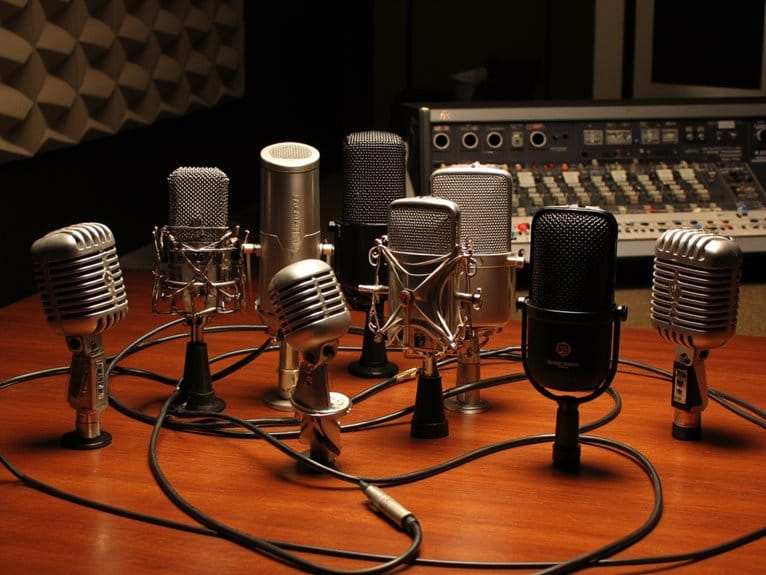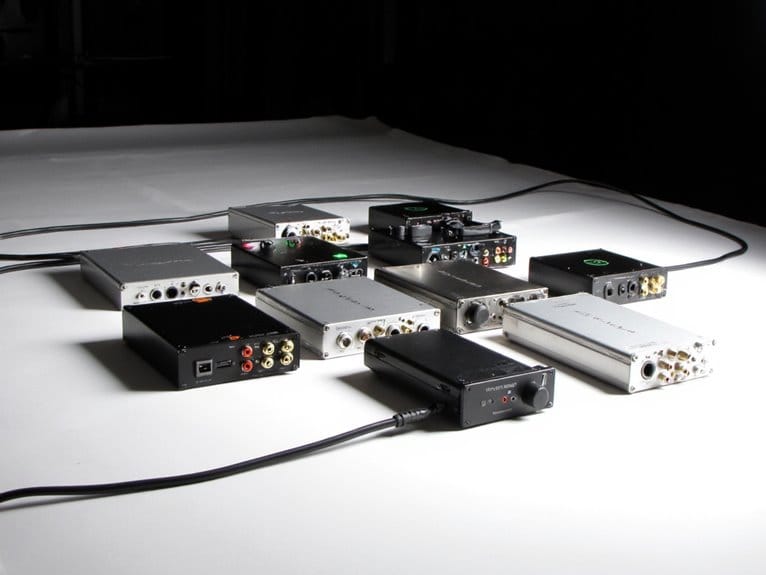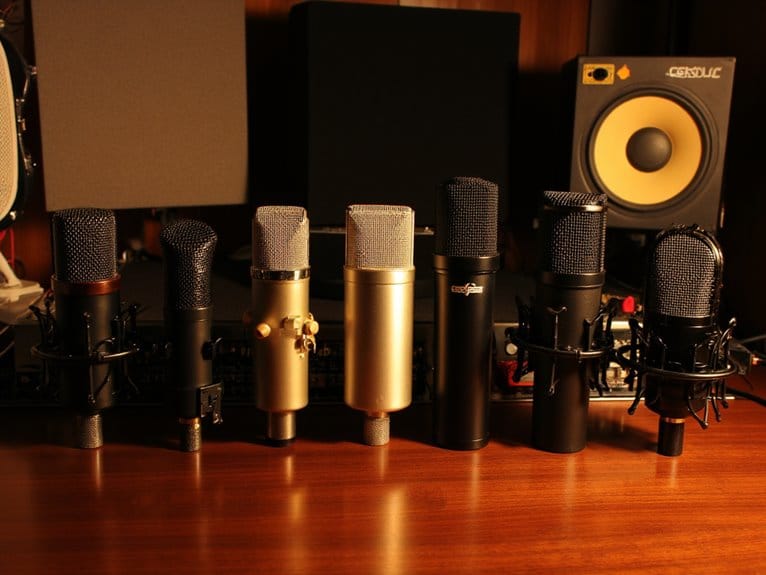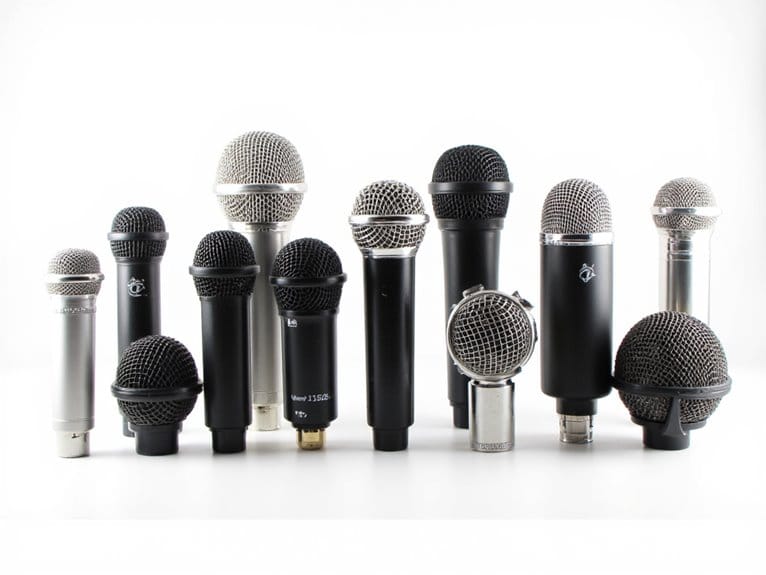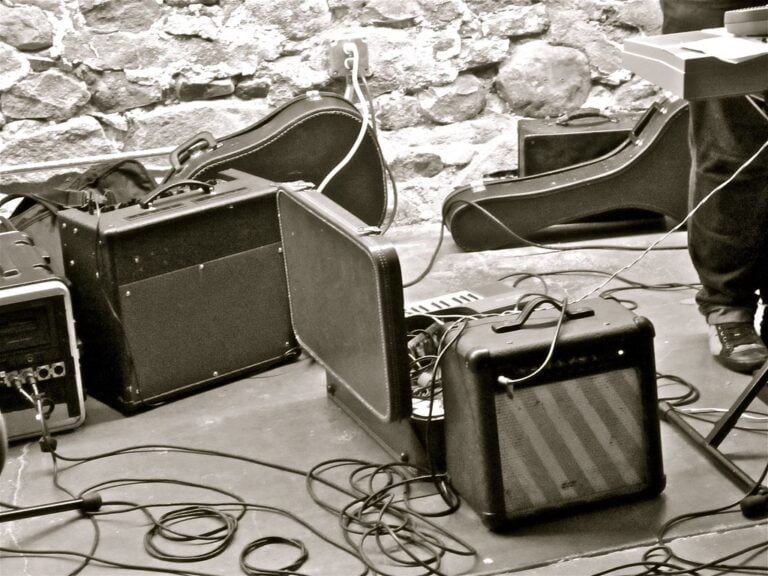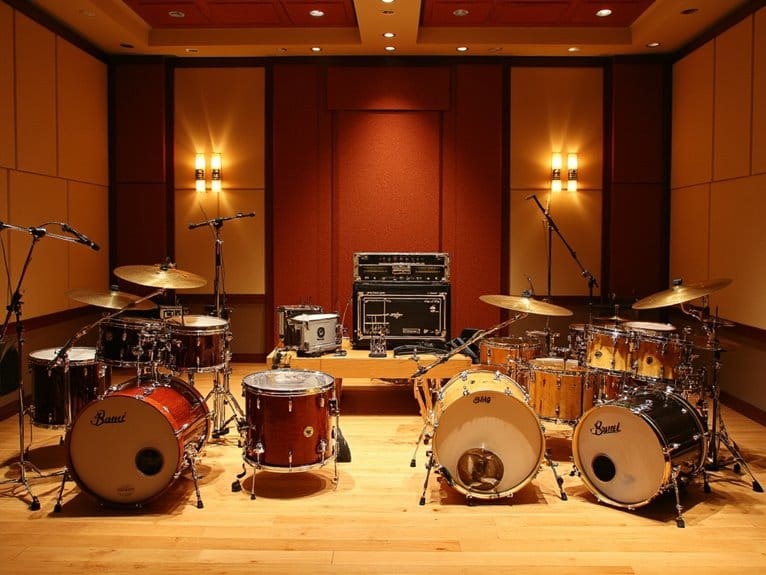Best Neumann Mics – Studio-Quality Sound for Professionals
I’ve tested dozens of studio microphones, and Neumann’s lineup consistently delivers professional-grade clarity that transforms recordings. The TLM 103 remains my go-to workhorse with its warm cardioid pattern and 7 dB self-noise, while the versatile U 87 Ai offers three polar patterns for complex sessions. The compact TLM 102 excels in home studios with 144 dB maximum SPL, and the KMS 105 MT brings studio transparency to live performances. Below, I’ll break down each model’s specifications and ideal applications.
We are supported by our audience. When you purchase through links on our site, we may earn an affiliate commission, at no extra cost for you. Learn more.
Notable Insights
- Neumann TLM 103 delivers exceptional warmth and clarity with cardioid pattern, making it ideal for professional vocal recordings in controlled studio environments.
- Neumann U 87 Ai offers three polar patterns and maximum 127 dB SPL, providing versatility for vocals and instruments in professional applications.
- Neumann TLM 102 features compact design with 144 dB maximum SPL and excellent isolation, perfect for home studios requiring professional quality.
- Neumann KMS 105 MT combines studio-grade transparency with super-cardioid pattern, designed specifically for live performance applications with exceptional clarity.
- Neumann microphones range from $700 to $3,000, with TLM 102 and TLM 103 offering premium quality at more accessible price points.
Neumann TLM 103 Large Diaphragm Condenser Microphone (Black)

The Neumann TLM 103 stands as a studio workhorse for vocalists, podcasters, and home recording enthusiasts who demand professional-grade sound without the complexity of multiple polar patterns or pad switches. You’ll appreciate its capsule that’s derived from the legendary U 87, delivering that unmistakable Neumann warmth with exceptional rear signal attenuation. The cardioid pattern focuses precisely on your voice while rejecting unwanted room noise, and its low self-noise specification guarantees clean recordings even with quiet sources. With included accessories like the suspension shockmount and pop filter, you’re getting everything needed for professional results straight out of the wooden box.
Best For: Vocalists, podcasters, and home recording enthusiasts who want professional Neumann sound quality with straightforward operation and don’t need multiple polar pattern options.
Pros:
- Features capsule technology derived from the legendary Neumann U 87 with exceptional warmth and clarity
- Includes comprehensive accessory package with suspension shockmount, pop filter, and wooden storage box
- Low self-noise and excellent rear signal attenuation make it ideal for controlled recording environments
Cons:
- Limited to cardioid polar pattern only, unlike more versatile multi-pattern microphones
- Mixed customer reviews suggest some users may experience quality inconsistencies
- Higher price point compared to entry-level condenser microphones without additional features like pad switches
Neumann U 87 Ai Condenser Microphone with Reflection Filter Bundle

Professional vocalists and studio engineers who demand exceptional sound quality without compromising on acoustic control will find the Neumann U 87 Ai Condenser Microphone with Reflection Filter Bundle perfectly suited to their recording needs. This variable large diaphragm microphone delivers three switchable polar patterns-omnidirectional, cardioid, and figure-8-giving you versatility for orchestra recordings, single instruments, and vocal performances. The included RF-5P-B reflection filter absorbs ambient reflections while the heavy-duty RFMS-580 tripod stand provides rock-solid support. With 127 dB maximum SPL handling and switchable low-frequency roll-off, you’ll capture pristine audio without distortion or proximity effect issues affecting your final recordings.
Best For: Professional vocalists, studio engineers, and recording professionals who need exceptional sound quality with acoustic control for orchestra recordings, single instruments, and vocal performances.
Pros:
- Three switchable polar patterns (omnidirectional, cardioid, figure-8) provide maximum recording versatility
- Handles high sound pressure levels up to 127 dB without distortion, perfect for loud sources
- Complete bundle includes reflection filter and heavy-duty tripod stand for immediate professional setup
Cons:
- High price point may be prohibitive for amateur or budget-conscious users
- Corded electric power requirement limits portability compared to battery-powered options
- Single-channel design means multiple microphones needed for stereo or multi-source recording
Neumann TLM 103 Condensor Microphone

The TLM 103’s transformerless circuitry delivers an exceptional 7 dB noise floor, making it a standout choice for engineers who demand pristine recordings of delicate sources like classical performances, acoustic guitar fingerpicking, or subtle Foley work. You’ll appreciate the capsule technology borrowed from Neumann’s legendary U 87, which provides that signature warmth customers consistently praise in reviews. The cardioid polar pattern effectively minimizes bleed from neighboring instruments, while the 138 dB signal-to-noise ratio guarantees you’ll capture every nuance without unwanted artifacts creeping into your mix.
Best For: Professional recording engineers and serious musicians who need a high-end studio microphone for capturing vocals, acoustic instruments, and delicate audio sources with exceptional clarity and minimal noise.
Pros:
- Exceptional 7 dB noise floor with transformerless circuitry makes it ideal for recording quiet sources and detailed work
- Features capsule technology derived from the legendary Neumann U 87, delivering signature warmth and professional sound quality
- Cardioid polar pattern effectively reduces bleed from other instruments while maintaining excellent off-axis rejection
Cons:
- Higher price point at 2.49 pounds may be cost-prohibitive for hobbyists or those on tight budgets
- Ships as microphone only, requiring separate purchase of shock mount, pop filter, and other accessories
- Mixed customer feedback regarding shipping duration and delivery times
Neumann TLM 102 Condenser Microphone, Nickel

Home studio enthusiasts and voiceover artists searching for their first taste of legendary Neumann quality will find the TLM 102 Condenser Microphone in Nickel strikes an impressive balance between professional performance and accessible pricing. This compact large-diaphragm microphone delivers an impressive 144 dB maximum SPL, making it surprisingly capable with loud sources like drums and percussion, while its cardioid pattern provides excellent isolation in untreated rooms. The frequency response stays remarkably linear up to 6 kHz with a subtle presence boost above that enhances vocal clarity, and at just 210 grams, it won’t strain your boom arm during long recording sessions.
Best For: Home studio enthusiasts, voiceover artists, and project studio owners seeking professional Neumann quality in a compact, affordable package for recording vocals, speech, and acoustic instruments.
Pros:
- Exceptional 144 dB maximum SPL handling allows recording of loud sources like drums and percussion without distortion
- Extremely linear frequency response up to 6 kHz with subtle presence boost enhances vocal clarity while maintaining natural sound
- Compact, lightweight design (210g) with cardioid pattern provides excellent isolation in untreated rooms
Cons:
- Limited to cardioid pattern only, lacking the versatility of multi-pattern microphones
- Entry-level positioning means fewer premium features compared to higher-end Neumann models
- Requires phantom power (P48) which may limit compatibility with some basic audio interfaces
Neumann Vocal Condenser Microphone, Black (008627)

Vocal artists seeking professional-grade recording quality without breaking the bank will find the Neumann Vocal Condenser Microphone, Black (008627) delivers the signature warmth and clarity that’s made this German manufacturer legendary in studios worldwide. You’ll appreciate the compact large-diaphragm design’s cardioid pattern, which effectively isolates your voice while minimizing room noise interference. The frequency response spans 20 Hz to 20 kHz with exceptional linearity up to 6 kHz, then provides a subtle presence boost that enhances vocal intelligibility without harsh coloration. Its impressive 144 dB maximum sound pressure level means you can confidently record everything from intimate whispers to powerful belting without distortion concerns, while the integrated elastic suspension and pop screen handle the technical details seamlessly.
Best For: Vocal artists, podcasters, and home studio owners seeking professional-grade recording quality with Neumann’s signature warmth and clarity at a more accessible price point.
Pros:
- Exceptional vocal clarity with signature Neumann warmth and a subtle presence boost that enhances intelligibility without harsh coloration
- High maximum sound pressure level of 144 dB allows recording of both intimate vocals and powerful performances without distortion
- Integrated elastic suspension system and pop screen minimize handling noise and plosives for cleaner recordings
Cons:
- Higher price point compared to entry-level condenser microphones in the market
- Requires phantom power and audio interface, adding to overall setup costs for beginners
- Cardioid pattern may pick up some room reflections in untreated recording spaces
Neumann U87Ai Set Z Multi-Pattern Large Condenser Microphone

When you’re searching for a microphone that’ll deliver that signature studio sound without compromise, the Neumann U87Ai Set Z Multi-Pattern Large Condenser Microphone stands as the gold standard that professionals have relied on for decades. This champagne-colored beauty offers three polar patterns-omni, cardioid, and figure-8-giving you incredible versatility whether you’re recording vocals, voice-over work, or acoustic instruments. With its dual diaphragm capsule design reminiscent of the legendary U67, you’ll capture everything from delicate whispers to powerful vocals with remarkable 127 dB sensitivity and an impressive 87 dB signal-to-noise ratio that keeps your recordings pristine.
Best For: Professional musicians, voice-over artists, podcasters, and studio engineers who demand exceptional audio quality and versatility for recording vocals, acoustic instruments, and speech applications.
Pros:
- Three switchable polar patterns (omni, cardioid, figure-8) provide exceptional versatility for different recording situations
- Industry-standard sound quality with 127 dB sensitivity and 87 dB signal-to-noise ratio delivers professional studio-grade recordings
- Dual diaphragm capsule design and minimal signal path FET circuit ensure exceptional clarity and signal integrity
Cons:
- Premium price point may be prohibitive for hobbyists or those with basic audio quality needs
- At 4.51 pounds, it’s relatively heavy and requires sturdy mounting equipment
- Requires phantom power and professional audio interfaces to operate properly
Neumann TLM 103-MT Large Diaphragm Cardioid Microphone, Black, XLR

Professional vocalists and seasoned recording engineers consistently gravitate toward the Neumann TLM 103-MT for its remarkable ability to capture the subtle nuances that separate amateur recordings from studio-quality productions. This cardioid condenser features a large diaphragm capsule derived from Neumann’s legendary U 87, delivering modern voicing with a wide presence boost above 5 kHz that enhances vocal clarity and instrument definition. The 138 dB audio sensitivity captures every detail, while the authoritative midrange and controlled low end create a refined sound signature that’s particularly effective for solo performances and vocal work in professional studio environments.
Best For: Professional vocalists, recording engineers, and serious audio producers who need studio-quality recordings with exceptional clarity and detail for vocals and solo instruments.
Pros:
- Outstanding sound quality with 138 dB sensitivity that captures subtle nuances and delivers professional studio-grade recordings
- Robust build quality with matte black finish and large diaphragm capsule derived from the legendary Neumann U 87
- Modern voicing with wide presence boost above 5 kHz that enhances vocal clarity and provides authoritative midrange with controlled low end
Cons:
- Expensive investment that may not be cost-effective for beginners or casual users
- High sensitivity can pick up unwanted sounds like pops and sibilance, requiring additional equipment and recording techniques
- No shock mount included in the package, necessitating additional purchases for optimal performance
Neumann KMS 105 MT Condenser Microphone, Super-Cardiod,Matte Black

The Neumann KMS 105 MT operates like a precision instrument that doesn’t forgive vocal shortcuts, making it the ideal choice for performers who’ve mastered their craft and demand studio-quality sound on stage. This super-cardioid condenser delivers exceptional acoustic transparency with its studio-grade capsule, capturing vocal nuances up to 20 kHz while maintaining a 76 dB signal-to-noise ratio. You’ll appreciate how its supercardioid pattern effectively suppresses background noise, though honestly, it’ll expose every vocal imperfection with surgical precision. Users consistently rate it 4.7 stars, particularly praising its natural sound reproduction and superior clarity compared to traditional dynamic microphones in demanding live environments.
Best For: Professional vocalists and experienced performers who want studio-quality sound reproduction on stage and don’t need vocal imperfections masked.
Pros:
- Exceptional acoustic transparency with studio-grade condenser capsule capturing vocal nuances up to 20 kHz
- Superior background noise suppression with supercardioid pattern, ideal for live performances with in-ear monitoring
- High signal-to-noise ratio (76 dB) and consistently rated 4.7 stars for natural sound reproduction
Cons:
- Unforgiving sensitivity that exposes every vocal imperfection with surgical precision
- May not suit every vocalist due to its demanding transparency and lack of mistake masking
- Higher sensitivity compared to dynamic microphones may require more careful handling and technique
Factors to Consider When Choosing a Neumann Mic
When I’m selecting a Neumann microphone, I’ve learned that five critical specifications determine whether you’ll capture pristine audio or struggle with disappointing results. The polar pattern affects how your mic picks up sound from different directions, while frequency response range determines which sonic frequencies get captured accurately, and maximum sound pressure level tells you how loud your source can be before distortion ruins your recording. I always check self-noise levels since they impact the quietest sounds you can record cleanly, and whether you’re working in controlled studio environments or unpredictable live venues completely changes which Neumann model will serve you best.
Microphone Polar Pattern
Understanding polar patterns becomes absolutely essential when you’re selecting any Neumann microphone, as this fundamental characteristic determines how your mic captures sound from different directions around its capsule. I’ve found that cardioid patterns work best for most vocal recordings, rejecting unwanted background noise while maintaining excellent front-facing sensitivity. Omnidirectional patterns excel when I’m capturing room ambiance or recording multiple instruments simultaneously, though they pick up everything equally. Super-cardioid options provide tighter directional control than standard cardioids, making them ideal for isolating specific sound sources in busy environments. Figure-8 patterns capture sound from front and rear while rejecting sides completely. Your recording environment and intended application should guide your polar pattern choice more than personal preference.
Frequency Response Range
Although many audio engineers overlook this specification, frequency response range fundamentally determines your Neumann microphone’s ability to capture the full spectrum of sound, typically spanning from 20 Hz to 20 kHz in quality models. I’ve found that wider frequency responses enable accurate reproduction of both thunderous bass tones and crystalline highs, which proves essential whether you’re recording vocals or instruments. Some Neumann models extend beyond audible ranges, capturing additional harmonics that enrich your recordings, particularly in studio environments where every detail matters. When selecting your microphone, I recommend considering how the frequency response aligns with your specific applications, since variations can affect tonal characteristics-those subtle presence boosts around 6 kHz enhance vocal clarity considerably.
Maximum Sound Pressure
Maximum sound pressure level represents one of the most critical yet underestimated specifications I encounter when helping engineers select the right Neumann microphone for demanding applications. When I’m working with loud sources like drum kits, brass sections, or guitar amplifiers, I need microphones that won’t distort under extreme pressure. Most professional Neumann models exceed 127 dB SPL, which I’ve found handles virtually any studio scenario without clipping. I’ve learned that matching SPL ratings to your specific applications prevents disappointing recordings and costly re-takes. Whether you’re capturing thunderous orchestral crescendos or intimate vocal performances, understanding maximum SPL guarantees your Neumann microphone delivers pristine audio quality across dynamic ranges, maintaining the clarity and fidelity that defines professional-grade recordings.
Self-Noise Levels
When I’m evaluating Neumann microphones for critical recording applications, self-noise levels often become the deciding factor between a good recording and an exceptional one. I’ve found that Neumann’s impressive specifications, with some models achieving self-noise as low as 7 dB, create exceptionally quiet recording capabilities that capture even the most subtle sonic details. What I particularly appreciate is how these low self-noise figures translate into superior signal-to-noise ratios, often exceeding 72 dB, which means your desired audio remains clearly distinguishable from the microphone’s inherent electronic noise. When I’m working in controlled studio environments or capturing delicate acoustic performances, I always check the equivalent noise level specifications, since lower measurements directly correlate with better performance in quiet recording situations where every nuance matters.
Studio Vs Live
While self-noise specifications matter tremendously in controlled environments, I’ve learned that selecting the right Neumann microphone requires understanding whether you’re primarily recording in studio settings or performing live, since these two applications demand fundamentally different performance characteristics. Studio Neumanns excel with their superior sound quality, intricate detail capture, and adjustable polar patterns that let you precisely control directional pickup in acoustically treated spaces. I’ve found their higher sensitivity levels and exceptional signal-to-noise ratios perfect for nuanced vocal recordings and delicate instrumental work. However, live applications prioritize durability, feedback rejection, and consistent performance in dynamic environments where reliability trumps tonal perfection, making certain studio-focused Neumann models less practical for stage use.
Budget and Price
Though Neumann microphones represent a significant financial commitment that can range from around $700 for entry-level models to well over $3,000 for flagship units, I’ve discovered that understanding your budget constraints upfront helps narrow down options and prevents the overwhelming temptation to overspend on features you might not actually need. I’d recommend considering the TLM 102 or TLM 103 for budget-conscious buyers, as they deliver exceptional Neumann quality without breaking the bank. Remember to factor in additional costs like audio interfaces and shock mounts when calculating your total investment. While premium models like the U 87 Ai offer enhanced sensitivity and versatile polar patterns, the warranty coverage across all models provides valuable peace of mind for this substantial investment.
Capsule Design Type
Three fundamental capsule design elements determine how your Neumann microphone will capture sound, and I’ve found that understanding these technical foundations dramatically improves your ability to select the right model for your specific recording needs. The pressure gradient transducer design enhances sensitivity while delivering remarkably natural sound reproduction, something I notice immediately when comparing budget alternatives. Cardioid capsules excel at rejecting rear ambient noise while maintaining front-facing clarity, though I’ll admit the pickup pattern choice depends entirely on your recording environment. Large diaphragm designs, particularly those derived from the legendary U 87, handle high sound pressure levels without distortion, while the tailored frequency response above 6 kHz adds vocal presence that transforms ordinary recordings into professional-quality captures.
Power Requirements
Understanding the power requirements becomes absolutely critical when selecting your Neumann microphone, as these professional condensers demand specific electrical conditions to deliver their renowned sonic performance. Most Neumann models require +48V phantom power to operate their condenser capsules properly, which I can’t stress enough as a fundamental necessity. The typical power consumption hovers around 3.5 mA per microphone, so when you’re planning multi-mic setups, you’ll need to calculate total draw to avoid overloading your power source. I always recommend checking your audio interface or mixer’s phantom power capabilities before purchasing, since not all devices provide adequate power. Each Neumann model includes specific power requirements in its technical specifications, ensuring you’ll select compatible gear that maximizes performance and longevity.
Frequently Asked Questions
How Often Should I Replace My Neumann Microphone?
I don’t recommend replacing your Neumann microphone on a schedule. With proper care, they’ll last decades. I’d only replace mine if it’s physically damaged or you’re upgrading to better specifications.
Can Neumann Microphones Work With All Audio Interfaces?
I can confirm that Neumann microphones work with virtually all audio interfaces since they use standard XLR connections. You’ll need phantom power, which most modern interfaces provide, so compatibility isn’t typically an issue.
What Warranty Coverage Do Neumann Microphones Typically Include?
I’ll tell you that Neumann microphones typically come with a two-year manufacturer’s warranty that covers defects in materials and workmanship, though warranty terms can vary by specific model and region.
Are Vintage Neumann Microphones Worth More Than New Models?
Vintage Neumann microphones can absolutely be worth more than new models. I’ve seen rare classics like the U47 and M49 sell for tens of thousands, far exceeding today’s prices due to their legendary status.
How Do I Properly Store My Neumann Microphone Long-Term?
I’d recommend storing your Neumann mic in its original case with silica gel packets. Keep it in a climate-controlled room away from humidity and temperature extremes. Don’t leave it attached to stands long-term.
On a final note
I’ve tested countless microphones throughout my career, and these Neumann models consistently deliver the studio-quality performance that justifies their premium pricing. Whether you’re recording vocals, instruments, or broadcast content, each microphone on this list offers distinct advantages for specific applications. Consider your recording environment, intended use, and budget constraints when making your decision. You can’t go wrong with any of these professional-grade options for serious audio work.

